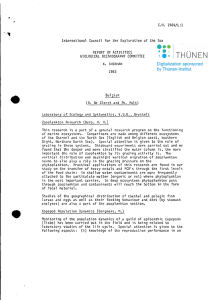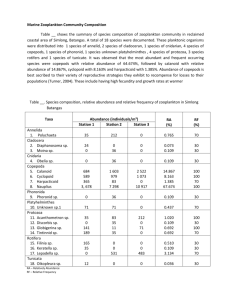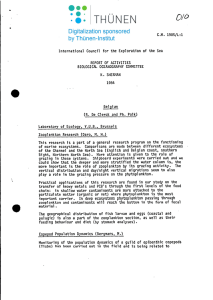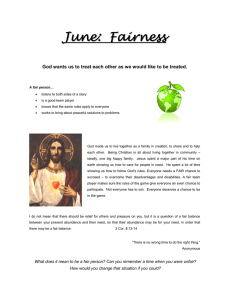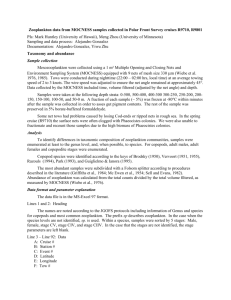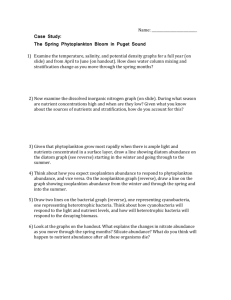Fulltext:
advertisement
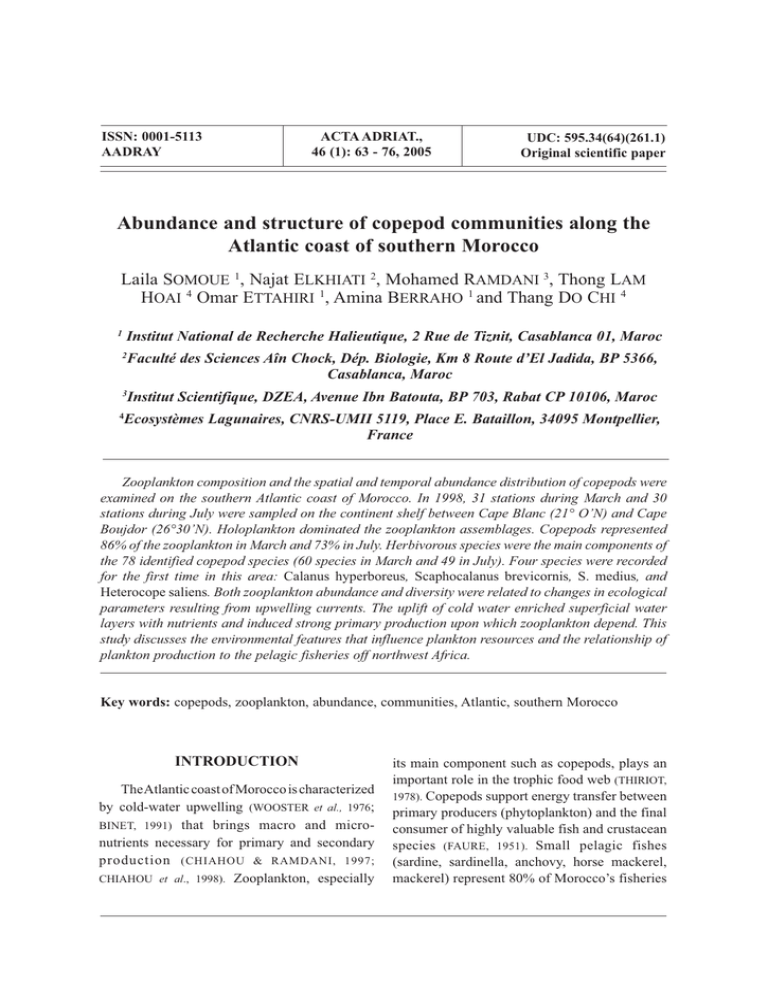
ISSN: 0001-5113 AADRAY ACTA ADRIAT., 46 (1): 63 - 76, 2005 UDC: 595.34(64)(261.1) Original scientific paper Abundance and structure of copepod communities along the Atlantic coast of southern Morocco Laila SOMOUE 1, Najat ELKHIATI 2, Mohamed RAMDANI 3, Thong LAM HOAI 4 Omar ETTAHIRI 1, Amina BERRAHO 1 and Thang DO CHI 4 1 Institut National de Recherche Halieutique, 2 Rue de Tiznit, Casablanca 01, Maroc 2 Faculté des Sciences Aîn Chock, Dép. Biologie, Km 8 Route d’El Jadida, BP 5366, Casablanca, Maroc 3 Institut Scientifique, DZEA, Avenue Ibn Batouta, BP 703, Rabat CP 10106, Maroc 4 Ecosystèmes Lagunaires, CNRS-UMII 5119, Place E. Bataillon, 34095 Montpellier, France Zooplankton composition and the spatial and temporal abundance distribution of copepods were examined on the southern Atlantic coast of Morocco. In 1998, 31 stations during March and 30 stations during July were sampled on the continent shelf between Cape Blanc (21° O’N) and Cape Boujdor (26°30’N). Holoplankton dominated the zooplankton assemblages. Copepods represented 86% of the zooplankton in March and 73% in July. Herbivorous species were the main components of the 78 identified copepod species (60 species in March and 49 in July). Four species were recorded for the first time in this area: Calanus hyperboreus, Scaphocalanus brevicornis, S. medius, and Heterocope saliens. Both zooplankton abundance and diversity were related to changes in ecological parameters resulting from upwelling currents. The uplift of cold water enriched superficial water layers with nutrients and induced strong primary production upon which zooplankton depend. This study discusses the environmental features that influence plankton resources and the relationship of plankton production to the pelagic fisheries off northwest Africa. Key words: copepods, zooplankton, abundance, communities, Atlantic, southern Morocco INTRODUCTION The Atlantic coast of Morocco is characterized by cold-water upwelling (WOOSTER et al., 1976; BINET, 1991) that brings macro and micronutrients necessary for primary and secondary production (CHIAHOU & RAMDANI, 1997; CHIAHOU et al., 1998). Zooplankton, especially its main component such as copepods, plays an important role in the trophic food web (THIRIOT, 1978). Copepods support energy transfer between primary producers (phytoplankton) and the final consumer of highly valuable fish and crustacean species (FAURE, 1951). Small pelagic fishes (sardine, sardinella, anchovy, horse mackerel, mackerel) represent 80% of Morocco’s fisheries 64 ACTA ADRIATICA, 46(1): 63-76, 2005 resources. Sardina pilchardus is the most dominant resource (ETTAHIRI et al., 2002). Fish stocks, recruitment, distribution, and abundance fluctuate with time and area. The aims of this paper were to (a) study the composition of the main planktonic taxa collected during the 1998 survey of the R/V ATLANTNIRO on the Atlantic coast of southern Morocco, (b) identify temporal and spatial variations in abundance and distribution of zooplankton, especially copepods, and (c) evaluate the importance of biotic relationships compared to hydrological features that influence the coastal pelagic fisheries ecosystem off northwest Africa. MATERIAL AND METHODS The Atlantic coast of southern Morocco is located between Cape Blanc (21°0’N) and Cape Boujdor (26°30’N). The width of the narrow continental shelf varies 15-60 miles. A permanent surface current from the Canary Islands parallels the coast from the northeast to the southwest. The confluence of the Equatorial North Current and the Equatorial Counter Current from the south (23°0’N) enhances water movement to the superficial and subsuperficial layers, creating a frontal zone with strong potential for biological production. The northeast trade winds generate upwellings along the coast, i.e., ascending vertical fluxes that lower the temperature of the water masses above the continental shelf and enrich them with macro and micro-nutrients. Hydrological data collected in 1995-8 indicated four upwelling latitudinal areas (A. MAKAOUI, pers. comm.): from Cape Cantin to Cape Ghir (32°30’-30°30’N), from Cape Draâ to Cape Juby (29°0’-28°0’N), from Cape Boujdor to Dakhla (26°0’-23°30’N), and from Cape Barbas to Cape Blanc (22°0’-21°0’N). Zooplankton were sampled during winter (March) and summer (July) 1998 between Cape Blanc and Cape Boujdor, a distance of 30 nautical miles on the latitudinal radial drawn seaward from the coast that separated the sampling stations (Fig. 1). The R\V ATLANTNIRO surveyed 31 sampling stations in March and 30 in July. Zooplankton were sampled according to a predetermined itinerary to cover all the stations in the shortest amount of time. Consequently, there was no need to take vertical migration of the zooplankton into account. Temperature (°C), salinity (psu), phosphate concentration (µagtl-1), and chlorophyll a biomass (mg m-2) were measured in the upper 100 m water layer Fig. 1. Zooplankton sampling stations during the 1998 cruise surveys of the oceanographic R/V ATLANTNIRO SOMOUE et al.: Abundance and structure of copepod communities along the Atlantic coast of southern Morocco at each station. Each cruise lasted about one month to obtain an overall view of the seasonal features. Zooplankton were collected with a 168-µm mesh Bongo net. The 20-cm circular opening of the net was equipped with a flow meter to estimate the volume of filtered water. “Sidestep” towing provides optimal cover of the water layer. It consists of dragging the net obliquely at a given depth for three minutes, then lifting it up vertically for one minute, dropping it obliquely to a second depth, again lifting it vertically, and repeating this action until the net reaches the surface. The towing speed varied 2-3 knots. The maximum sampling depth did not exceed 100 m. Copepods were identified according to ROSE (1933), TRÉGOUBOFF & ROSE (1957), VERVOORT (1963, 1965), CASANOVA (1977) and RAZOULS (1982). Zooplankton were analyzed under a stereomicroscope and density was expressed as individuals per m3. Only adult copepods were counted; younger stages (copepodites and nauplii) were discarded and not counted. The abundance of pelagic fish eggs and larvae (ind m-2), with all species pooled together, was provided by A. BERRAHO (pers. comm.). Each station was characterized by copepod assemblage, expressed as specific richness (S; number of encountered species), total density (Q), and SHANNON’s index (H; SHANNON & WIENER, 1949), expressed as H = ∑Pi Log2Pi , where Pi = dominance of species i, computed as Pi = ni/N, ni = number of species i in sample, and N = number of samples. The maximum evenness (Hmax) indicates the potential state in which the abundance is evenly distributed amongst the different populations in the community and is expressed by the logarithm of taxonomic richness (S). If the SHANNON’s diversity index (H) of a community is weighted through Hmax, the resulting ratio or evenness indicates the degree of potential ecological niche occupation by different populations for a given taxonomic richness. According to LLOYD & GHERLARDI (1964), evenness or equitability (0<H/log2S<1) allows estimating the abundance diversification level of the community, while supposing that at the maximal diversification level all populations have the same abundance. 65 Such information provides a general view of the spatial and temporal organization of zooplankton communities. Zooplankton occurrence was measured by total zooplankton abundance (Qz), total copepod abundance (Qc), copepod richness (Rc) and copepod diversity index (Hc), and by abundance of the pelagic fish eggs (PE) and larvae (PL). Station 14 in winter and station 7 in summer were abnormally poor in zooplankton (<3 ind m-3) and discarded from data analyses. Therefore, a principal component analysis (PCA) was applied to the data compiled from 29 stations in each seasonal survey, using temperature, salinity, phosphate concentration, and chlorophyll a biomass as main variables, and zooplankton components (i.e., total zooplankton abundance, total copepod abundance, copepod richness, and diversity index) and abundance of pelagic fish eggs and larvae as supplementary variables to identify relationships between zooplankton communities and other parameters (Microsoft Excel package). Abundances were transformed into Log (x+1). RESULTS Main hydrological features of the site In 1998, upwelling areas were delimited between Cape Boujdor and Dakhla, and between Cape Barbas and Cape Blanc, with a stronger intensity in summer (from 250 m depth near Cape Boujdor) than in winter (from 100 m). In March 1998, salinity of the superficial layer varied 36.24-36.92 psu. Temperature ranged 18.1-20.6°C. Values higher than the mean (17.5°C) were recorded mostly in the southern stations and at some stations north of Cintra Bay. Phosphate concentrations at 10 of the 29 stations were above the mean 0.30 µgat l-1, and in some cases reached 0.81µgat l-1 (south of Dakhla). Enrichment above the continental shelf decreased towards latitude 26°30’N, where the phosphate concentration was below the mean. In July, the temperature range was wider (15.7-21.4°C). Salinity (36.12-36.62 psu) did not significantly differ from winter values. Sta- 66 ACTA ADRIATICA, 46(1): 63-76, 2005 tions with a phosphate concentration above the mean (0.28 µgat l-1; maximum1.17 µgat l-1) were scattered throughout the studied area. High phosphate concentrations, often in conjunction with a low temperature, indicated an upwelling zone. Chlorophyll a ranged 13.9-190.5 mg m-2 in March and 9.5-152.6 mg m-2 in July. Values higher than the winter mean concentration (47.5 mg m-2) were observed at the confluence of the southern and northern Atlantic central waters, where the phosphate concentration was lower than the mean. The same trend was seen in summer (mean 53.7 mg m-2), with high values mainly at the northern stations in the upwelling areas. Composition and abundance of zooplankton The collected zooplankton was composed essentially of neritic holoplankton organisms and a minor meroplanktonic, represented by several taxonomic groups, namely (a) Holoplankton appendicularians, chaetognaths, euphausiaceans, ostracods, cladoceran, and amphipods, copepods, mysidaceans, hydrozoans, siphonophores, salpids, doliolids, and isopods, and (b) meroplankton, including annelids, mollusks, cirripeds, and decapods (Table 1). Copepods were the dominant group in both seasons, reaching 86% in March and 73% in July. The 78 species belonged to 24 families. Most were inshore pelagic inhabitants and some Table 1. Composition of copepods in March and July 1998 off the southern Atlantic coast of Morocco Taxon Acartia clausi (Giesbrecht, 1889) Acartia danae (Giesbrecht, 1889) Acartia grani (G.O. Sars, 1904) Acartia longiremis (Lilljeborg, 1853) Acartia tonsa (Dana, 1848) Aegisthus dubius (G.O. Sars, 1916) Aegisthus spinulosus (Farran, 1905) Arietellus setosus (Giesbrecht, 1892) Augaptilus megalurus (Giesbrecht, 1892) Augaptilus spinifrons (G.O. Sars, 1907) Calanus brevicornis (Lubbock, 1856) Calanoides carinatus (Kröyer, 1849) d Calanus helgolandicus (Claus, 1863) Calanus hyperboreus (Kröyer, 1838) * Calanus minor (Claus, 1863) Calocalanus sp. Candacia bipinnata (Giesbrecht, 1892) d Candacia elongata (Boeck, 1872) Candacia varicans (Giesbrecht, 1892) Centropages sp. Centropages chierchiae (Giesbrecht, 1889) Centropages hamatus (Lilljeborg, 1853) Centropages kroyeri (Giesbrecht, 1892) Centropages typicus (Kröyer, 1863) March (%) 8.56 0.02 0.01 1.33 July (%) 18.63 0.02 0.53 0.03 0.01 0.01 0.01 0.02 0.01 0.38 4.19 24.37 0.55 6.44 0.12 0.18 3.49 3.02 0.83 15.86 2.08 0.47 0.10 0.49 0.29 0.65 0.06 2.51 SOMOUE et al.: Abundance and structure of copepod communities along the Atlantic coast of southern Morocco Table 1. Cont’d Centropages violaceus (Claus, 1863) Corycaeus sp. Corycaeus clausi (Fdahl, 1894) Corycaeus typicus (Kröyer, 1849) Ctenocalanus vanus (Giesbrecht, 1888) d Diaixis pygmoea (T. Scott, 1899) Eucalanus crassus (Giesbrecht, 1888) d Eucalanus elongatus (Dana, 1848) d Eucalanus monachus (Giesbrecht, 1888) Euchaeta pubera (G.O. Sars, 1907) Euchaeta spinosa (Giesbrecht, 1892) Euterpina acutifrans (Norman, 1903) Heterocope saliens (G.O. Sars, 1863) * Mecynocera clausi (J.C. Thompson, 1888) d Labidocera sp. Lucicutia atlantica (Wolfenden, 1904) d Lucicutia tunuicoda (G.O. Sars, 1907) Macrosetella gracilis (Dana, 1852) Microcalanus pusillus (G.O. Sars, 1903) Monstrilla grandis (Giesbrecht, 1892) Monstrilla helgolandica (Claus, 1863) Oithona brevicornis (Giesbrecht, 1891) Oithona helgolandica (Claus, 1863) Oithona linearis (Giesbrecht, 1891) Oithona nana (Giesbrecht, 1891) Oithona plumifera (Baird, 1843) Oncaea curta (G.O. Sars, 1916) Oncaea minuta (Giesbrecht, 1892) Oncaea tennella (G.O. Sars, 1916) Oncaea venusta (Philippi, 1843) Paracalanus aculeatus (Giesbrecht, 1892) Paracalanus nanus (G.O. Sars, 1907) Paracalanus parvus (Claus, 1863) Paracalanus pygmaeus (Claus, 1863) Paraeuchaeta sp. Paraeuchaeta glacialis (Hansen, 1886) Paraoithona parvula (Farran, 1908) Phyllopus bidentatus (Brady, 1883) Pleuromamma abdominalis (Lubbock, 1856) d Pleuromamma gracilis (Claus, 1863) d Pseudocalanus elongatus (Boeck, 1872) d 0.02 3.02 1.55 7.87 0.02 0.02 0.03 0.01 0.01 0.01 0.02 0.08 0.01 0.02 0.04 0.01 0.03 0.01 0.16 0.08 0.88 3.64 0.05 0.18 0.02 0.01 0.03 0.35 2.21 10.23 0.01 0.22 0.01 0.08 2.39 0.10 0.08 0.05 1.81 8.70 0.89 0.06 0.10 0.06 4.57 0.06 0.02 2.54 0.98 2.44 0.62 0.86 4.63 15.55 0.04 0.82 0.02 0.43 0.70 67 68 ACTA ADRIATICA, 46(1): 63-76, 2005 Rhincalanus cornitus (Giesbrecht, 1888) d Rhincalanus nasutus (Giesbrecht, 1888) Scaphocalanus brevicornis (G.O. Sars, 1903) * Scaphocalanus echinatus (Farran, 1909) Scaphocalanus magnus (T. Scott, 1894) d Scaphocalanus medius (G.O. Sars, 1907) * Scolecithricella ovata (Frran, 1905) Scottocalanus persecans (Giesbrecht, 1892) Scotulla abyssalis (G.O. Sars, 1905) Temora longicornis (O.F. Müller, 1792) Temora stylifera (Dana, 1848) Undeuchaeta plumosa (Lubbock, 1856) 0.04 0.03 0.03 0.01 4.58 9.02 0.01 Unidopsis bradyi (G.O. Sars, 1884) 0.03 0.03 0.41 0.01 0.06 0.09 0.03 1.15 5.56 3.71 0.06 * = found for the first time in studied areas = deep water species might have been pushed toward the open sea by currents and winds. Deep water species were determined according to SEGUIN (1973), SEGUIN et al. (1993), CHIAHOU & RAMDANI (1997), and BELFQUIH (1980). Four species were identified for the first time in the studied area: (a) Calanus hyperboreus occurred in March at 11 coastal stations (1, 5, 8, 10-13, 16, 19, 24, and 29), (b) Heterocope saliens, rare in the region, was observed during the summer survey at two inshore stations (13 and 29), (c) Scaphocalanus brevicornis was found in July at three open sea stations (5, 6, and 25) and two inshore stations (16 and 23), and (d) S. medius, more eurytherm, was present during both March and July at coastal stations 5 and 13, in March at open sea station 3, and in July at inshore station 16 and open sea station 9. Zooplankton are classified as strictly herbivorous (HS), preferentially herbivorous (HP), or carnivorous (C) by BELFQUIH (1980). Four dominant species, Calanus helgolandicus (HS), Paracalanus parvus (HS), Acartia clausi (HP), and Corycaeus typicus (C), together constituted 51% of the copepod density in winter and 57% in summer (Fig. 2 a, b). However, the Fig. 2.a) Average composition of dominant copepod species in March 1998 SOMOUE et al.: Abundance and structure of copepod communities along the Atlantic coast of southern Morocco 69 Fig. 2. b) Average composition of dominant copepod species in July 1998 proportion of C. helgolandicus, a cold water species, decreased from 24% in winter to 15% in summer, while A. clausi, a warm water species, was more abundant in summer (18%) than winter (9%). For all species, there were about 25 copepodites for 100 adults. The total abundance of zooplankton decreased from 202 ind m-3 in March to 148 ind m-3 in July, showing spatial and temporal fluctuations of strong amplitude (Fig. 3). Copepods followed a similar abundance distribution, since they were the dominant component of the zooplankton community, with higher densities at Cape Barbas and north of Cape Blanc. Copepod densities ranged 3-183 ind m-3 in March and 2-83 ind m-3 in July. The highest densities were recorded in the upwelling zones: at coastal stations near Cape Boujdor, in the areas surrounding Dakhla and Cape Barbas, and at the inshore station near Cape Blanc. Zooplankton and hydrological environment relationships Hydrological variables such as temperature (T), salinity (S), phosphate concentration (PO), and chlorophyll a biomass (Ca) provide information about environmental conditions where zooplankton are found (CHIAHOU, 1997; CHIAHOU & RAMDANI, 1997). The axes of the PCA for the March data explained 78% of the total variance (Fig. 4a). Axis F1 positively correlated to salinity and temperature and negatively correlated to phosphate concentration. F 2 positively correlated to chlorophyll a biomass, representing primary production. Zooplankton and copepod abundance were greater in colder areas that were well supplied with chlorophyll. No particular trend related copepod richness and diversity index (high in cold water) to S or PO. Pelagic fish eggs and larvae were more abundant in warmer water. A biplot of the stations shows a V-shaped GUTTMAN effect (SEGUIN et al., 1993; CHIAHOU, 1997), reflecting gradient dependent data (Fig. 4b). The station dispersal may be explained first by salinity and phosphate level, then by temperature. For example, stations 3, 4, 6, and 7 off Cape Boujdor were located in warm water with high salinity and few nutrients, while stations 28-31 south of Cape Barbas were located in colder nutrient-rich water. Pelagic fish eggs and larvae were abundant in the latter stations, as well as zooplankton and copepods. The stations 70 ACTA ADRIATICA, 46(1): 63-76, 2005 Fig. 3. Spatial fluctuation of zooplankton densities (individuals m-3) in winter and summer 1998. (a) total zooplankton and (b) copepods Fig. 4. Principal components analysis of hydrological variables in March 1998: (a) correlation of axes F1 and F2 with main variables of temperature (T), salinity (S), phosphate concentration (PO), and chlorophyll a biomass (Ca) and with supplementary variables of total zooplankton abundance (Qz), total copepod abundance (Qc), copepod richness (Rc), copepod diversity (Hc), pelagic fish eggs (PE), and larvae (PL) abundance; (b) biplot display of the stations SOMOUE et al.: Abundance and structure of copepod communities along the Atlantic coast of southern Morocco were dispersed along the temperature axis. High and average zooplankton abundance was found mostly in the lower half of the biplot display, in both coastal and offshore stations. The PCA biplot of July data also explains a high percentage of the variance (89%). Axis F1 shows temperature and salinity at one end and phosphate concentration at the opposite end (Fig. 5a). Higher salinity corresponded with warmer water that was poor in phosphates. Chlorophyll a biomass highly correlated with the F2 axis. Zooplankton abundance, copepod richness and diversity, as well as pelagic fish eggs and larvae are represented in the upper half of the ordination space, in the chlorophyll-rich water. The gradient of the stations shows the GUTTMAN effect (Fig. 5b). Chlorophyll acts as the dispersal factor along axis F2; most of the stations are located in areas of low chlorophyll and poor in zooplankton and pelagic fish eggs and larvae. Only 16, 22, 24, 26, 27, and 29 (between Dakhla and Cape Blanc) appeared to be rife with fish expending larvae. Densities of pelagic fish eggs above 100 ind m-2 and pelagic fish larvae above 10 ind m-2 were located between Cape Blanc and Cintra Bay in March, with the abundance increasing toward 25°N in July. 71 Copepod community structures In March, the copepod assemblages were formed by numerous species (10-25, mean 17). The high evenness (0.72<E<0.95) indicated structured and balanced communities in terms of abundance distribution. In July, the specific richness tended to be lower (4-26, mean 14), and the evenness ranged 0.46-0.88, reflecting less structured communities, with a more pronounced abundance gap between populations. Plotting the samples on the H and Hmax = log(S) axes according to LIU KINGHONG (1995) allows visualizing the community at each station (Fig. 6). In winter, the communities were rich or very rich in species, with a relatively equilibrated abundance profile. In the summer, a greater variety of structure was observed: (a) a small number of stations (2-4, 11, and 15 north of Dakhla) had poor species communities and an unbalanced abundance profile; (b) a few stations (1, 10, and 12) were somewhat richer in species and had a more equilibrated abundance profile; (c) a large number of stations (south of 24°N) and some stations far from the coast (5, 6, 8, 13, and 14 in the north) were rich or very rich Fig. 5. Principal components analysis of hydrological variables in July 1998. For explanation, see caption to Fig. 4 72 ACTA ADRIATICA, 46(1): 63-76, 2005 Fig. 6. SHANNON diversity index (H) of copepods in relation to specific richness (Hmax = Log2S) for each station in (a) winter and (b) summer in species, with a relatively balanced abundance profile as in winter. DISCUSSION The south Moroccan Atlantic coast is characterized by year-round upwelling (WOOSTER et al., 1976; BINET, 1991) that raises micro-nutrients and lowers the surface water temperature. The area at 21-23°N is a frontal zone of the north and south Atlantic central waters that are rich in the micro-nutrients necessary for primary and secondary production (MINAS et al., 1982). The total zooplankton densities found in this study were lower than data found in the literature. On the El Jadida coast (Morocco), the maximum abundance of copepods exceeded 300 ind m-3 in winter and reached 900 ind m-3 in summer (CHIAHOU & RAMDANI, 1996; CHIAHOU, 1997). In the coastal lagoon of Moulay Bousselham (Morocco), zooplankton were found at 4000 ind m-3 in winter and 16 000 ind m-3 in summer (BENBAKHTA, 1994). In the present study, young copepods were discarded, resulting in underestimated counts. Further, differences in the present study may be due to differences between the coastal inshore stations (which are mesotrophic and eutrophic) and the open sea stations (which are oligotrophic). Zooplankton densities were high in the upwelling waters of Cape Boujdor in March and July, in the Dakhla area in March, and in the coastal stations at 21-23°N in both months. Copepods accounted for 73% of the zooplankton and were SOMOUE et al.: Abundance and structure of copepod communities along the Atlantic coast of southern Morocco the most abundant group. The high abundance recorded far offshore on the 24°N transect could be related to the upwelling that characterized this region (A. MAKAOUI, pers. comm.). The dominance of copepods was reported for several pelagic ecosystems throughout the world and off the coasts of Morocco (THIRIOT, 1978; BELFEQUIH, 1980; BOUCHER, 1982; BENBAKHTA, 1994; CHIAHOU & RAMDANI, 1997; CHIAHOU et al., 1998). FAURE (1951) noted that the maximum copepod abundance occurred during upwelling (92.6% of the total zooplankton). Among the species reported in this study, four were new records for the investigated area. Calanus hyperboreus occurred in March at 11 stations, Scaphocalanus brevicornis was collected in July at five stations, and S. medius was collected in both months at five stations. According to ROSE (1933), C. hyperboreus is present in northern Atlantic cold and deep waters (west of Ireland, Arctic Sea), S. brevicornis lives above 200 m in the boreal Atlantic waters (Shetland, Gulf of Biscay), and S. medius dwells in the Atlantic and Pacific oceans. It was surprising to collect Heterocope saliens twice in summer since ROSE (1933) noted that most Heterocope species live in lakes of continental Europe and one species in the Caspian Sea. BRADFORD-GRIEVE et al. (1999) confirmed the lacustrine as the primary habitat of this genus. During both months, the copepod community was dominated by Calanus helgolandicus, Paracalanus parvus, Acartia clausi, and Centropages typicus. Their percentages differed between months. Abundance tended to decrease as the species were found far from their preferential habitat. Calanoides carinatus dominated in Senegal and Ivory Coast waters (SEGUIN, 1981). Northward, in the Atlantic waters of Morocco, A. clausi, C. helgolandicus, and C. typicus dominated the zooplankton assemblages (BELFEQUIH, 1980). These species were associated with Acartia discaudata, A. grani, and P. parvus in the coastal waters of El Jadida (CHIAHOU, 1997). Four of them (A. clausi, P. parvus, C. helgolandicus, C. typicus), together with Oithona helgolandica, Euterpina acutifrons, and Temora stylifera, formed important populations in the 73 coastal lagoon of Moulay Bousselham, Morocco (BENBAKHTA, 1994). The zooplankton abundance corresponded with ecological parameters (phosphate, chlorophyll a), especially in the southern section of the surveyed area. Pelagic fish eggs and larvae also tended to be abundant south of 24°N. Spatial and temporal abundance fluctuations seemed to be linked to the dynamics of the water upwelling that characterizes the south Atlantic Moroccan inshore ecosystem. TOURÉ (1971), BAINBRIDGE (1972), and MÉDINA-GAETNER (1985) reported that upwelling had a positive effect on zooplankton abundance and that most of the abundance peaks occurred during these water-ascending periods. Among the environmental parameters, low temperature and low salinity corresponded to high concentrations of phosphates and chlorophyll a, corroborating observations by ROY (1992) from the pelagic ecosystem of the northwestern African coast. ROY (1992) noted a negative linear relationship between nutrients and temperatures below 22°C. High concentrations of phosphates and low temperatures allow development of different plankton compartments. ROY (1992) stated that temperature fluctuations are good indicators of the variability of nutrient input: several days after a decrease in temperature, the enrichment of water leads to intensive primary and secondary production. In March, the copepod community was wellstructured with a diversified and equilibrated abundance distribution among populations. In July, the community became relatively more disturbed, and less species diversity and structure were found. The difference in community structure between the cold and warm seasons is related to hydrological conditions (ROY, 1992). In our study, the upwelling intensity was very important in summer and caused plankton blooms that benefited some copepod populations (P. parvus, A. clausi, C. typicus and Temora longicornis), a consequence that may explain the low diversity index during this season. Strong upwelling periods are characterized by less diversified communities (BAINBRIDGE, 1972; BOUCHER, 1982; JACQUES & 74 ACTA ADRIATICA, 46(1): 63-76, 2005 TRÉGUER, 1986; DIOUF, 1991). MÉDINA-GAERTNER (1985) found that upwelling periods correspond to lower specific richness of zooplankton in the Bay of Dakar. This study was a first step toward exploration of the potential links between hydrological parameters and phytoplankton compartment, which represents the main trophic resource for zooplankton in this important fisheries area. The results of this study contribute to integrated exploration of the larval recruitment of pelagic fishes. ACKNOWLEDGMENT This study was achieved within the FranceMorocco REMER program (REseau des Sciences et Techniques de la MER). REFERENCES The zooplankton of the Gulf of Guinea. Bull. Mar. Ecol., 8: 61-97. BELFEQUIH, M. 1980. Les copépodes du plateau atlanto-marocain. Un cycle annuel dans les zones d’upwelling. Thèse 3ème cycle, Université Aix-Marseille I, 126 pp. BENBAKHTA, B. 1994. Structure et dynamique du zooplancton de la lagune de Moulay Bousselham (Maroc). Thèse 3ème cycle. Université. Mohammed V, Faculté des Sciences Rabat, 125 pp. BINET, D. 1991. Dynamique du plancton dans les eaux côtières ouest-africaines : écosystèmes équilibrés et déséquilibrés. Pêcheries ouestafricaines. Ed. ORSTOM, pp. 117-136. BOLTOVSKOY, D. 1999. SouthAtlantic Zooplankton. Backhuys Publishers, Leiden, 1705 pp. BOUCHER, J. 1982. Peuplement de copépodes des upwellings côtiers nord-ouest africains. II Maintien de la localisation spatiale. Oceanologica Acta, 5(2): 199-207. CASANOVA, J.P. 1977. La faune pélagique profonde. Zooplancton et micronecton de la province atlanto-méditerranéenne. Aspects taxonomiques, biologiques et zoogéographiques. Thèse Doctorat d’Etat, Université de Provence (Aix Marseille I), 462 pp. CHIAHOU, B. 1997. Les copépodes pélagiques de la région d’El Jadida (côte atlantique marocaine). Etude faunistique, écologique et biogéographique. Thèse Doctorat d’Etat, Faculté des Sciences El Jadida, 168 pp. CHIAHOU, B. & M. RAMDANI. 1996. Observations sur les variations de la densité et de la biomasse des copépodes pélagiques des BAINBRIDGE, V. 1972. côtes atlantiques marocaines (région d’El Jadida) au cours d’un cycle annuel. Marine Life, 6(1-2): 21-25. CHIAHOU, B. & M. RAMDANI. 1997. Systématique et distribution saisonnière des copépodes pélagiques de la côte atlantique marocaine (région d’El Jadida). J. Recherche Océanographique, 22(3): 75-80. CHIAHOU, B., M. RAMDANI & M. MENIOUI. 1998. Structure biogéographique des copépodes des côtes marocaines. Rapp. Comm. int. Mer Médit., 2, pp. 406-407. DIOUF, P.S. 1991. Le zooplancton au Sénégal: écosystèmes équilibrés et déséquilibrés. Pêcheries ouest-africaines. Ed. ORSTOM, pp. 103-116. ETTAHIRI, O., A. BERRAHO, G. VIDY, M. RAMDANI & T. DOCHI. 2003. Observation of the spawning of Sardina and Sardinella off the south Moroccan Atlantic coast (21-26°N). Fish. Res., 60: 207-222. FAURE, M.L. 1951. Le zooplancton de la zone côtière du Maroc. Année 1950. Conseil International pour l’Exploration de la Mer. Annale Biologie, 8: 66-68. JACQUES, G. & P. TRÉGUER. 1986. Les écosystèmes pélagiques marins. Masson. Paris, New York, Barcelona, Milan, 243 pp. LIU KINGHONG, L. 1995. A model for species diversity monitoring at community level and its applications. Environ. Monitoring Assessment, 34: 271-287. LLOYD, M. & R.J. GHELARDI. 1964. A table for calculating the evenness composant of species diversity. J. An. Ecol., 33: 217-225. SOMOUE et al.: Abundance and structure of copepod communities along the Atlantic coast of southern Morocco Etude du zooplancton côtier de la Baie de Dakar et de son utilisation par les poissons comme source de nourriture. Thèse 3ème cycle, Université Bretagne Occidentale, 141 pp. M É D I N A - G A E RT N E R , M . 1 9 8 5 . MINAS, H.J., L.A. CODISPOTI & R.C. DUGDALE. 1982. Nutrient and primary production in the upwelling region of northwest Africa. Rapport Conseil International pour l’Exploration de la Mer., 180: 148-183. RAZOULS, C. 1982. Répertoire mondial taxonomique et bibliographique provisoire des copépodes planctoniques marins et des eaux saumâtres. Université Paris VI, 875 pp. ROSE, M. 1933. Copépodes pélagiques. Faune de France 26. P. Lechevalier (Editor). Paris. 374 pp. ROY, C. 1992. Réponses des stocks de poissons pélagiques à la dynamique des upwellings en Afrique de l’Ouest : Analyse et Modélisation. Ed. ORSTOM. Collection Etudes et Thèses, Paris, pp. 5-146. SEGUIN, G. 1973. Cycles comparés du zooplancton dans l’ouest africain et la Méditerranée sud-occidentale. Etude systématique, quantitative et écologique. Thèse Doctorat d’Etat, Université Lille, 168 pp. SEGUIN, G. 1981. Cycle annuel des copépodes pélagiques en rade Villefranche-SurMer à partir de l’analyse de prélèvements quotidiens (Années 1972). Bull. d’Ecologie, 12(1): 29-60. SEGUIN, G., R. GAUDY., A. ERRHIF & D. THIBAULT. 1993 . Observation sur l’abondance, la 75 composition taxonomique et les affinités écologiques des copépodes pélagiques récoltés dans la région du front AlmeriaOran. Mar. Life, 3(1-2): 19-29. SHANNON, C. & E. WIENER. 1949. The Mathematical Theory of Communications. Urbana Illinois Press, 117 pp. THIRIOT, A. 1978. Zooplankton communities in the west African upwelling area. In: R. Boje, M. Tomzak (Editors). Upwelling Ecosystems, New York, pp. 32-61. TOURÉ, D. 1971. Variation quantitative du zooplancton dans la région du Cap-Vert de septembre 1970 à août 1971. Doctorat Scientifique. Centre de Recherche Océanographique-Dakar-Thiaroye (CRODT), 39, 25 pp. TRÉGOUBOFF, G. & M. ROSE. 1957. Manuel de planctonologie méditerranéenne: I & II, CNRS Paris, 1: 1-181. VERVOORT, W. 1963. Pelagic copepoda. Part. I. Copepoda calanoida of the families Phaennidae up to and including Euchaetidae. Atlantide Rep., 7: 77-194. VERVOORT, W. 1965. Pelagic copepoda. Part. II. Copepoda calanoida of the families Phaennidae up to and including Acartiidae, containing the description of a new species of Aetideidae. Atlantide Rep., 8: 9-216. WOOSTER, W.S., A. BAKUN & D.R. MC LAIN. 1976. The seasonal upwelling cycle along the eastern boundary of the north Atlantic. J. Mar. Res., 34: 131-141. Received: 25 August 2004 Accepted: 24 January 2005 76 ACTA ADRIATICA, 46(1): 63-76, 2005 Abundancija i struktura kopepodnih zajednica uzduž atlantske obale južnog Maroka Laila SOMOUE 1, Najat ELKHIATI 2, Mohamed RAMDANI 3, Thong LAM HOAI 4 Omar ETTAHIRI 1, Amina BERRAHO 1 and Thang DO CHI 4 1 Nacionalni institut za ribarstvena istraživanja, 2 Rue de Tiznit, Casablanca 01, Maroko Facultet znanosti Aîn Chock, Biološki odjel, Km 8 Route d’El Jadida, P.P. 5366, Casablanca, Maroko 3 Znanstveni institut, DZEA, Avenue Ibn Batouta, P.P. 703, Rabat CP 10106, Maroko 4 Lagunarni ekosistemi, CNRS-UMII 5119, Place E. Bataillon, 34095 Montpellier, Francuska 2 SAŽETAK Istraživani su sastav, te prostorna i vremenska raspodjela kopepoda u južnoatlantskom obalnom području Maroka. U 1998. godini materijal je sakupljen na 31 postaji tijekom ožujka i na 30 postaja tijekom srpnja iznad kontinentalnog šelfa, između Cape Blanc-a (21° O’N) i Cape Boujdor-a (26°30’N). U zooplanktonskim zajednicama je prevladavao holoplankton. Kopepodi su sačinjavali 86% zooplanktona u ožujku i 73% u srpnju. Unutar 78 identificiranih kopepoda prevladavale su herbivorne vrste (60 vrsta u ožujku i 49 u srpnju). Po prvi put se za područje spominju četiri vrste: Calanus hyperboreus, Scaphocalanus brevicornis, S. medius i Heterocope saliens. Abundancija i različitost zooplanktona ovisile su o promjenama ekoloških parametara izazvanih strujama “upwellinga”. Uzdizanje hladnije vode obogaćivalo je površinske slojeve hranjivim tvarima i time omogućilo porast primarne proizvodnje, o kojoj je ovisan zooplankton. U ovoj studiji se raspravlja o uvjetima sredine koji utječu na planktonske resurse i odnosima između planktonske proizvodnje i pelagijskog ribarstva u obalnom području sjeverozapadne Afrike. Ključne riječi: Kopepodi, zooplankton, abundancija, zajednice, Atlantik, južni Maroko


